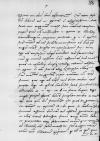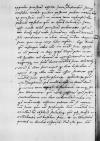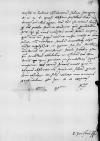Cum iam fasciculum litterarum ad Vestram Reverendissimam Dominationem obsignassem, accersivit me ⌊reginalis maiestas⌋, scire volens causam, propter quam non interfuisset Vestra Reverendissima Dominatio ⌊conventui Marienburgensi⌋ proxime praeterito, quod Vestra Dominatio Reverendissima suam maiestatem, ad eam scribens, remiserit ad litteras, quas ⌊regiae maiestati⌋ scripsit in excusationem sui, tum ego non ausus sum aliquid occultare, nam praemonitus eram, quod mecum easdem litteras afferrem ad suam maiestatem. Quas et exhibui, dixique utramque rationem absentiae Vestrae Reverendissimae Dominationis non secus atque descripsit illas. Tum ⌊maiestas reginalis⌋ coepit enumerare mihi omnia ferme, quae ego ab aliis vel dicta audivi, vel scripta legi, de quibus abunde satis prioribus certiorem reddo Dominationem Vestram Reverendissimam, et d in fine dixit: „Ego, inquit, propter duos homines frequenter audio a ⌊maiestate regia⌋: ’Ecce quam bene procedunt isti, quos tu promovisti’”, et nominavit Vestram Reverendissimam Dominationem, de qua se habuisse spem hidden by binding⌈[spem]spem hidden by binding⌉ firmam asseruit, dum eam ad episcopatum promovit, quod scilicet hidden by binding⌈[cilicet]cilicet hidden by binding⌉ in ⌊illis terris⌋ debuisset fieri dux omnis boni et promotor, atque fautor orig. fotor⌈fautorfautor orig. fotor⌉ earum rerum, quae vergant ad commodum non solum ⌊maiestatis regiae⌋, sed ⌊regni⌋ etiam. Nunc autem contrarium experitur, quod ab eo tempore, quo Vestra Reverendissima Dominatio  AAWO, AB, D. 5, f. 88v appulit ⌊Prussiam⌋, exortae sint illic superinscribed⌈illicillic superinscribed⌉ discordiae iamque consilia ineunt, quibus possent ⌊Polonae nationis homines⌋ ex ⌊Prussia⌋ eicere, et nemo tam infensum se superinscribed in place of crossed-out na⌈na se se superinscribed in place of crossed-out na⌉ Polonis exhibet quam ⌊dominus episcopus Culmensis⌋. „Iam ipse vult totam ⌊Prussiam⌋ gubernare written over t⌈trere written over t⌉, ipse cum al duobus aliis vult summam rei ⌊illarum terrarum⌋ sibi vendicare”. Et alia huiusmodi multa dixit ⌊maiestas sua⌋, quae vix unus liber caperet.
AAWO, AB, D. 5, f. 88v appulit ⌊Prussiam⌋, exortae sint illic superinscribed⌈illicillic superinscribed⌉ discordiae iamque consilia ineunt, quibus possent ⌊Polonae nationis homines⌋ ex ⌊Prussia⌋ eicere, et nemo tam infensum se superinscribed in place of crossed-out na⌈na se se superinscribed in place of crossed-out na⌉ Polonis exhibet quam ⌊dominus episcopus Culmensis⌋. „Iam ipse vult totam ⌊Prussiam⌋ gubernare written over t⌈trere written over t⌉, ipse cum al duobus aliis vult summam rei ⌊illarum terrarum⌋ sibi vendicare”. Et alia huiusmodi multa dixit ⌊maiestas sua⌋, quae vix unus liber caperet.
Ego deinde, quando refrixit calor ille in ⌊maiestate sua⌋, excusavi non paucis et dixi, quicquid concipere potui in re non sperata ad honorem et excusationem Vestrae Reverendissimae Dominationis, rogavique, ne fidem daret maiestas sua delatoribus, verum si certior fieri cupit, quod haec describat Vestrae Reverendissimae Dominationi, quod illa nihil non esset factura, quicquid maiestas sua praescripserit. Pollicitaque quidem est se superinscribed⌈sese superinscribed⌉ scripturam, sed mallet ipsa in faciem dicere, quod nemo tam copiose describeret et neque forsan conveniret, quam verbis exprimere ipsa posset. Conturbavit me hoc vehementer, video enim, quid incommodi afferre poterit, etiam si vera non sint, quae iam persuasa h(ab)et ⌊maiestas sua⌋. Nullum tamen consilium salubrius, quam quod scripsi, ut reconciliatio cum ⌊Kostka⌋ fiat et in conventibus pietas in dandis responsis. Nam isti, qui habent  AAWO, AB, D. 5, f. 89r causas in iudicio consiliariorum, solent spargere de Vestra Reverendissima Dominatione, quasi contemptim pusillos habeat et duriter cum illis agat. Nam hoc est vitium hominum, quod eos putant facere et decernere, qui pronuntiant. Fero ego quoque eius molestiae meam sortem, impingitur enim mihi, quicquid nomine et iussu ⌊maiestatis regiae⌋ dico.
AAWO, AB, D. 5, f. 89r causas in iudicio consiliariorum, solent spargere de Vestra Reverendissima Dominatione, quasi contemptim pusillos habeat et duriter cum illis agat. Nam hoc est vitium hominum, quod eos putant facere et decernere, qui pronuntiant. Fero ego quoque eius molestiae meam sortem, impingitur enim mihi, quicquid nomine et iussu ⌊maiestatis regiae⌋ dico.
Alia non vacat scribere avocantibus aliis multis negotiis. Dominatio Vestra Reverendissima sit sui similis, scilicet constans et prudens. Facile sedabit ista, cum prudentiam adhibebit in consilium. Sed imprudens ego, qui peritiori et prudentiori leges impono, sed verum fraternus amor, quo Vestram <Dominationem> Reverendissimam complector, non sinit, ut sileam, proinde boni consulat et feliciter valeat, me amans.
 AAWO, AB, D. 5, f. 88v appulit
AAWO, AB, D. 5, f. 88v appulit  AAWO, AB, D. 5, f. 89r causas in iudicio consiliariorum, solent spargere de Vestra Reverendissima Dominatione, quasi contemptim pusillos habeat et duriter cum illis agat. Nam hoc est vitium hominum, quod eos putant facere et decernere, qui pronuntiant. Fero ego quoque eius molestiae meam sortem, impingitur enim mihi, quicquid nomine et iussu
AAWO, AB, D. 5, f. 89r causas in iudicio consiliariorum, solent spargere de Vestra Reverendissima Dominatione, quasi contemptim pusillos habeat et duriter cum illis agat. Nam hoc est vitium hominum, quod eos putant facere et decernere, qui pronuntiant. Fero ego quoque eius molestiae meam sortem, impingitur enim mihi, quicquid nomine et iussu 


